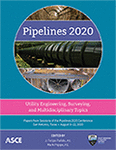Pipelines 2020
Mutual Learning: A Comparison between the Dutch and International Utility Surveying Practices
Publication: Pipelines 2020
ABSTRACT
The collection and depiction of comprehensive and accurate information about subsurface utilities’ locations and attributes—also referred to as utility surveying—has been a priority in the planning, design and monitoring of construction projects for many years. Where internationally comparable utility surveying standards have established (e.g., the British PAS 128, the American ASCE 38-02, the Australian AS 5488, and the Malaysian Standard Guideline for Underground Utility Mapping), this has not occurred in the Netherlands. Given the lack of a utility surveying standard, this study examines how the Dutch utility surveying practice is arranged, specifically looking at the localization of utilities prior to excavation works. Our findings show that the Netherlands primarily benefits from utility plans, verified trough trial trenches, while seemingly neglecting the commissioning of geophysical methods. This practice mainly originates from the availability of a regulated central utility data-exchange platform and the obligation by law to precisely determine the location of utilities prior to excavation. After qualitatively comparing the Dutch utility surveying practice with the practices as outlined by the international utility surveying standards, we argue that two fundamental differences may provide lessons for both the Dutch and international surveying practices. In specific, Dutch practice may learn from international practices that geophysical detection methods provide a complementary means to reduce excavation risk besides utility plans and trial trenches, whereas the international context, in turn, may learn that having a regulated central utility data-exchange platform helps to enhance the availability of utility plans.
Get full access to this article
View all available purchase options and get full access to this chapter.
REFERENCES
AS (Australian Standards). (2013). Classification of Subsurface Utility Information (SUI), AS 5488-2013.
ASCE (American Society of Civil Engineers). (2002). Standard Guideline for the Collection and Depiction of Existing Subsurface Utility Data, ASCE 38-02 https://doi.org/10.1061/9780784406458.
Chapman, D. N., Rogers, C. D. F., Burd, H. J., Norris, P. M., & Milligan, G. W. E. (2007). Research needs for new construction using trenchless technologies. Tunnelling and Underground Space Technology, 22(5–6), 491–502. https://doi.org/10.1016/j.tust.2007.05.003.
Costello, S. B., Chapman, D. N., Rogers, C. D. F., & Metje, N. (2007). Underground asset location and condition assessment technologies. Tunnelling and Underground Space Technology, 22(5–6), 524–542. https://doi.org/10.1016/j.tust.2007.06.001.
Hao, T., Rogers, C. D. F., Metje, N., Chapman, D. N., Muggleton, J. M., Foo, K. Y., Saul, A. J. (2012). Condition assessment of the buried utility service infrastructure. Tunnelling and Underground Space Technology, 28(1), 331–344. https://doi.org/10.1016/j.tust.2011.10.011.
ICE (Institution of Civil Engineers). (2014). Specification for underground utility detection, verification and location,.
Jaw, S. W., & Hashim, M. (2013). Locational accuracy of underground utility mapping using ground penetrating radar. Tunnelling and Underground Space Technology, 35, 20–29. https://doi.org/10.1016/j.tust.2012.11.007.
Kern, F., & Smith, A. (2008). Restructuring energy systems for sustainability? Energy transition policy in the Netherlands, 36, 4093–4103. https://doi.org/10.1016/j.enpol.2008.06.018.
Kraus, E., Obeng-Boampong, K., & Quiroga, C. (2012). Utility Investigation Trends in Texas. Transportation Research Record, 2309(1), 209–217. https://doi.org/10.3141/2309-20.
Lai, W. W., Xavier, D., & Annan, P. (2018). A review of Ground Penetrating Radar application in civil engineering: A 30-year journey from Locating and Testing to Imaging and Diagnosis. NDT and E International, 96, 58–78. https://doi.org/10.1016/j.ndteint.2017.04.002.
Lester, J., & Bernold, L. E. (2007). Innovative process to characterize buried utilities using Ground Penetrating Radar. Automation in Construction, 16, 546–555. https://doi.org/10.1016/j.autcon.2006.09.004.
Metje, N., Atkins, P. R., Brennan, M. J., Chapman, D. N., Lim, H. M., Machell, J., Thomas, A. M. (2007). Mapping the Underworld – State-of-the-art review. Tunnelling and Underground Space Technology, 22(5–6), 568–586. https://doi.org/10.1016/j.tust.2007.04.002.
Yin, R. K. (2014). Case Study Research Design and Methods. 5ed. London: Sage.
Information & Authors
Information
Published In
Pipelines 2020
Pages: 372 - 380
Editors: J. Felipe Pulido, OBG, Part of Ramboll and Mark Poppe, Brown and Caldwell
ISBN (Online): 978-0-7844-8321-3
Copyright
© 2020 American Society of Civil Engineers.
History
Published online: Aug 6, 2020
Published in print: Aug 6, 2020
Authors
Metrics & Citations
Metrics
Citations
Download citation
If you have the appropriate software installed, you can download article citation data to the citation manager of your choice. Simply select your manager software from the list below and click Download.
